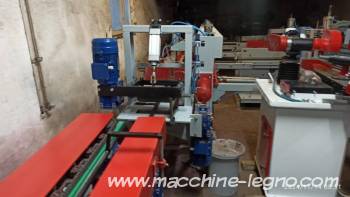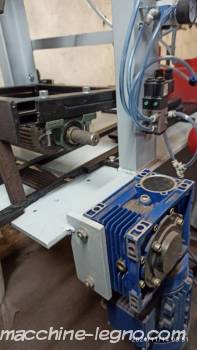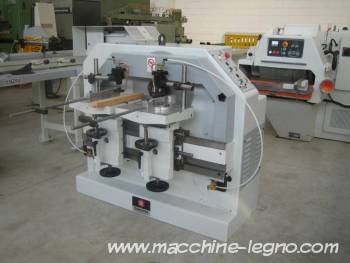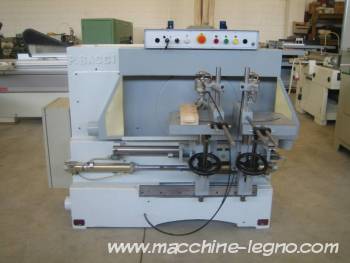line for joining wood to length famad packages double tenoning machine automatic
LINE FOR JOINING WOODEN ELEMENTS TO LENGTH PDFD
Category: I - Technological lines
The PDFD line consists of two basic components: a DFC 60 milling-tenoning machine socket (where the ends of the strips are processed) and a PHSL press for joining to length, on which the elements are joined into a strip up to 6.6 m long with the possibility of programming up to eight intercuts dividing the strip into sections of a length programmed by the service. Between these basic devices there are transport devices that also perform the function of pre-tenoning. The presented configuration of the line allows for obtaining an efficiency of approx. 8,000 m/shift.
The microprocessor control system allows for flexible adjustment of operating parameters to the user's needs. The presented machine has the ability to process "calzing" type elements as well as elements for the production of countertops (joined "on a line"). The use of a receiving table with automatic feeding of strips to the PHSL press input conveyor allows the line to be operated by a single employee feeding the elements. The receiving table is equipped with a buffering screen that increases efficiency and smoothness of work. The line operates in an automatic cycle with manual material feeding. The line components can be assembled in various configurations (agreed with the recipient) enabling the machine to be adapted to the user's local conditions.
Technical and operational data
Width of the milling-tenoning machine input package mm 650
Width of glued elements mm 30 ÷ 155
Length of glued elements mm 170 ÷ 900
Thickness of glued elements mm 20 ÷ 70
Air working pressure MPa 0.6
Compressed air demand m3/h approx. 25
Working efficiency cycl./min. up to 4 (6600 strip)
Length of glued element mm 4500 ÷ 6600
Operating voltage V AC 3/N/PE 400 V 50 Hz
Control voltage V DC 24
Power demand kW max 100
Description of operationTechnical parameters of the DFC 60 D milling and tenoning machineTechnical parameters of the PHSL press
Wooden strips are fed by the operator onto the trolley of the first milling and tenoning machine. Feeding the elements initiates the milling machine work cycle. The first milling machine aligns the bundle fronts and then mills the dovetail outline. The bundle is fed onto the table of the second milling and tenoning machine, where the other side of the bundle is processed and glue is applied.
Elements fed from the DFC - 60 D tenoning machine via a chain conveyor are fed into the pre-tenoning unit, where a set of shafts and a presser are used to pre-clamp the wedge joint of the squares before they are fed into the press.
The pre-tenoned squares are directed to the press table, where, after reaching the required length, they are cut. Then, using a pusher strip and a pressure strip, they are moved to the pressure bed area, where the pressing process takes place. The glued and pressed, ready strip is pushed onto the press receiving table.
After moving the squares to the pressure bed area, the process of feeding the elements to the press table takes place in parallel with the above-described activities. This maintains continuous operation of the press, and thus allows for increased gluing efficiency.
possibility of making inter-cuts of a pre-tenoned strip,
number of programmable sections – 10,
measurement accuracy approx. 10 mm on a single section (depending on the number and length of the tenoned elements)
Working cutters with a diameter from ?200 to ?250 (optionally ?160 to ?200) – not included in the scope of delivery
- Poland
- použité






































